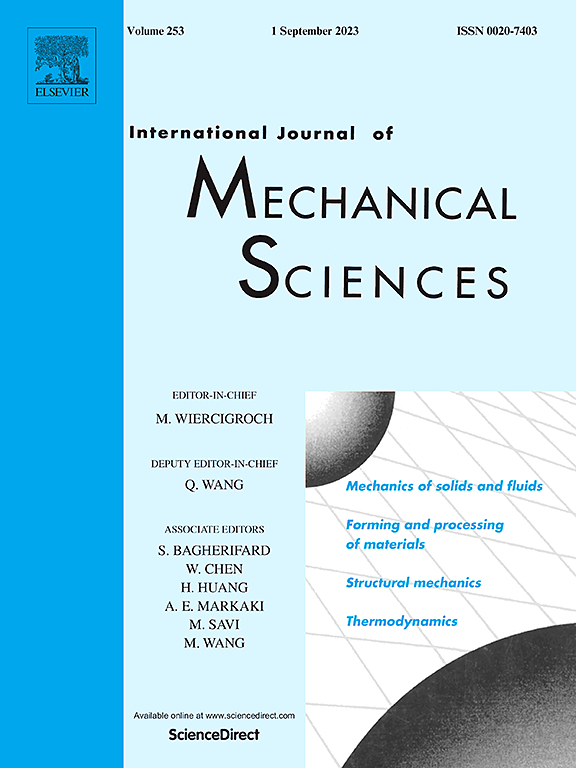Structural galloping suppression with high-frequency flutter
IF 7.1
1区 工程技术
Q1 ENGINEERING, MECHANICAL
International Journal of Mechanical Sciences
Pub Date : 2025-02-01
DOI:10.1016/j.ijmecsci.2025.109928
引用次数: 0
Abstract
Galloping presents a significant challenge in engineering, often causing large-amplitude vibrations in structures such as suspended electrical cables, bridges and towers, posing substantial risks and property damage. While injecting high-frequency excitations can mitigate structural galloping, current active suppression methods, which apply excitations after galloping has developed, are suboptimal, limiting their widespread adoption. In this study, a low-cost and easy-to-implement passive galloping suppression approach utilizing flutter-induced vibrations is proposed, exhibiting robust anti-galloping effects under natural wind conditions. By strategically placing flags, high-frequency fluttering forces generated by wind flow are exploited to impose surface loads on the structure rapidly. This preemptively suppresses low-frequency galloping, mitigating its onset effectively without necessitating substantial force. A distributed aerodynamic model is developed to simulate the suppression phenomenon, accompanied by a comprehensive analysis considering factors such as flutter characteristics, wind speed, and flag position and geometric parameters. The analysis also explores distinct suppression mechanisms that arise when the fluttering frequency approaches the second and third modal frequencies of the structure. The proposed galloping suppression approach has been successfully simulated and validated through theoretical calculations and experimental tests, and test results showcase a significant reduction in vibration amplitudes, with suppression ratios ranging from 85% to 95% across wind speeds of 3 m/s to 10 m/s. Additionally, this approach demonstrates effective suppression capabilities under variable wind speed conditions, indicating its reliability and practicality for mitigating detrimental galloping in real-world scenarios.

求助全文
约1分钟内获得全文
求助全文
来源期刊

International Journal of Mechanical Sciences
工程技术-工程:机械
CiteScore
12.80
自引率
17.80%
发文量
769
审稿时长
19 days
期刊介绍:
The International Journal of Mechanical Sciences (IJMS) serves as a global platform for the publication and dissemination of original research that contributes to a deeper scientific understanding of the fundamental disciplines within mechanical, civil, and material engineering.
The primary focus of IJMS is to showcase innovative and ground-breaking work that utilizes analytical and computational modeling techniques, such as Finite Element Method (FEM), Boundary Element Method (BEM), and mesh-free methods, among others. These modeling methods are applied to diverse fields including rigid-body mechanics (e.g., dynamics, vibration, stability), structural mechanics, metal forming, advanced materials (e.g., metals, composites, cellular, smart) behavior and applications, impact mechanics, strain localization, and other nonlinear effects (e.g., large deflections, plasticity, fracture).
Additionally, IJMS covers the realms of fluid mechanics (both external and internal flows), tribology, thermodynamics, and materials processing. These subjects collectively form the core of the journal's content.
In summary, IJMS provides a prestigious platform for researchers to present their original contributions, shedding light on analytical and computational modeling methods in various areas of mechanical engineering, as well as exploring the behavior and application of advanced materials, fluid mechanics, thermodynamics, and materials processing.
 求助内容:
求助内容: 应助结果提醒方式:
应助结果提醒方式:


